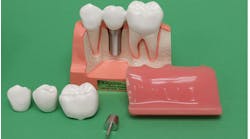April is here and the year is moving along. I have challenged you to work on building blocks to move your practice forward, and you must have a plan. Without a plan, things happen to you instead of you charting your path moving upward and forward.
What is discombobulation?
There are times when I am in a state of discombobulation. It happens to everyone. So, what is discombobulation? It’s when something makes us feel confused and uncomfortable. We may feel nostalgia for the past and uncertainty about the future.
But there’s something else related to discombobulation: a state of confusion. Why is this not working? Why won’t this come out right? We strive for perfection, yet we can’t achieve the best possible result when we are in a state of discombobulation.
How it affects dentistry
When you start doing complex dentistry and seating a single crown, you may become frustrated. When things don’t go well, along comes discombobulation. For example, tooth no. 19 will be cemented after a few weeks of a comfortable temporary. Everything’s been fine; the insertion visit should be easy. You’re using a lab you’ve used 100 times before. You haven’t changed anything and yet things start to happen.
Read more from the author ...
Overcoming your challenges: Is it your smarts, or is it something else?
Is there room for improvement? Here's how to get better
You have systems to assure that the crown is in your office at the right time. It works like this: the crown must be in the office at least one day ahead of the patient’s appointment. When your office receives the crown, it’s noted in your appointment book and is placed where anyone can find it.
Let’s say you’ve removed the temporary crown, cleaned off the cement, managed the bleeding, the color is perfect, but the crown won’t seat. What can you do to get out of this uncomfortable position? You must be systematic in your approach, but sometimes you just can’t come up with a way out of the problem. You end up having to solve a series of problems. I call this binary thought, and here’s how to do it.
Binary thought and discombobulation
In this example, you’d ask these questions and go through this thought process:
- Does the crown fit on the model? No, it does not, so it must be redone.
- Does the model look like the tooth? No, it does not, so you need to take a new impression.
- Does the crown seat on the tooth? No, it does not, so you need to check the contacts.
We all know the problems, but we have to accept the solutions. This can get even more complex. Once I was placing an implant-supported bridge with eight abutments. The abutments were on the model, and the bridge was on the abutments. Everything was looking great. I removed the abutments with the seating jig and tried them in the patient’s mouth. The screws wouldn’t screw into the multiunit abutment in the mouth. What was I going to do? We need to know how to figure out the problem and get to the solution.
Discombobulation was happening big-time, and then a hygiene check came and added to the pressure. Ask these questions in a systematic way:
- Do things fit on the model? Yes.
- Do the screws fit in the mouth? No.
Aha, the problem is revealed. Somehow, the lab used the wrong multiunit abutments and therefore the wrong screws, and now nothing will work. Who is the second person who needs to know about this?
The patient needs to know. Say, “This is what has happened, and we need to redo something to get the results we both want.” There’s no one to blame; you just need to work on the solution.
It’s impossible to avoid being in a state of discombobulation from time to time. You can’t avoid it the busier you get. But there are steps to keep it from happening every day. The key: you must have a system for figuring things out. The binary approach will help you with this:
- If this happens, then I need to do A or B.
- If I choose B and it doesn’t work, then I need to do A.
- If that doesn’t work, I need to move on to C.
Doing the same thing over and over and expecting a different result is total nuts! If you’re giving lidocaine for a procedure and the patient isn’t numb, you need to do something different. If you don’t know any other method, you need to learn various techniques for numbing the patient.
If you do beautiful dentistry based on great science and in a businesslike manner, you will find balance in your life. But you can’t do it when you’re discombobulated, so you absolutely must have systematic methods for balancing: art, science, and the business of dentistry.
Editor's note: This article appeared in the April 2023 print edition of Dental Economics magazine. Dentists in North America are eligible for a complimentary print subscription. Sign up here.






